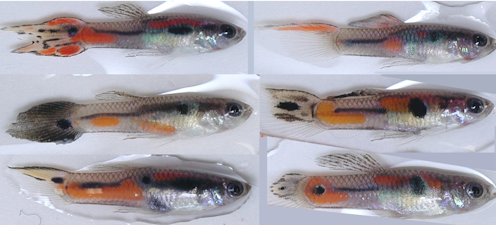Boredom in the mating market: Guppies demonstrate why it’s good to stand out
The mating habits of these tiny, colorful fish may be revealing something broader about the animal kingdom, and perhaps even our own desires.

If you’re looking for love, it pays to stand out from the crowd. Or at least that’s how it works in some parts of the animal kingdom. Scientists have found that in several species – green swordtail fish, Trinidadian guppies, fruit flies, Poecilia parae fish – ladies overwhelmingly go for the guy that looks different from the rest.
But the reason for this attraction to novelty has remained a mystery. So my colleagues and I used the Trinidadian guppy to investigate the psychology behind why many females have an affinity for the unusual.
Male features that attract females
The guppy has long been a workhorse for biologists like me who are interested in understanding the mating decisions that animals make and the evolutionary forces behind those decisions. Male guppies attempt to woo females using courtship dances that show off the elaborate color patterns adorning their bodies. The females of the species are color pattern connoisseurs, carefully choosing among their suitors based, in large part, on their visual appeal. This tendency has made the guppy an excellent model for studying mate choice.
Many types of animals exhibit what evolutionary biologists call directional preferences, an attraction to more of a certain thing – think bigger antlers, a longer tail or brighter color spots. And there are evolutionary theories that help make sense of these preferences. If a male can grow more extreme features, that can be a sign that he is in good physical condition, has good genes, or would make a good parent.
What’s less clear, though, is why females should value unusualness in a mate.
When puzzling over why this mating preference arose, it occurred to me that attraction to novelty fits with a simple kind of learning called habituation. Psychologists have long known that when an animal is repeatedly exposed to some stimulus – be it a sound, a touch or in this case a visual pattern – it responds to the stimulus less and less. This occurs because the nervous system starts to “tune out” repetitive information. Since repetitive information is usually unimportant, habituation helps to free up the animals attention for other more important things.
What’s interesting about habituation is that it’s pervasive: Virtually every animal species, including human beings, can habituate to a wide range of things. It’s the reason why the noise from the air conditioning unit seems loud and distracting when it first turns on, but before long you barely notice it.
I wondered if this might be happening in guppies. If females are tuning out the color patterns they commonly see, then a male with a different-looking pattern is going to have a huge advantage attracting mates.

Testing whether habituation is what’s happening
To test this idea, I had to determine whether preference for novel-looking males meets four key criteria of habituation.
First I needed to see whether repeated exposure to a stimulus – like the noisy air conditioner, or a particular color pattern – made the animals less interested in that thing. Scientists call this “responsiveness decline.” To test it, I took a group of female guppies and exposed them to a series of males that looked alike. Then, I observed how the females behaved toward a male with the now-familiar pattern.
Male guppies are persistent suitors, and females mostly ignore their courtship dances. But when a male catches their fancy, females will turn and approach the male, which can lead to copulation. The effect of exposure to males was striking: Females already familiar with the pattern responded about half as often to male courtship compared to females that had never seen any male color patterns before. I also found it took just 12 minutes of exposure to reduce female responsiveness, which shows that female interest is fleeting.
Next, I had to show whether isolating females from the stimulus causes their responsiveness to increase again, something called “spontaneous recovery.” This would be like the air conditioning unit turning off for a while, and then being noticeable again when it flips back on. I found that isolating females for a short period after exposure made them more responsive when I observed their behaviors with the familiar-looking male, meeting this criterion.
The third criterion is called dishabituation: After responsiveness to a stimulus has declined, exposure to a different stimulus should cause responsiveness to increase again. For instance, hearing the siren of a passing police car would make you notice the droning of the air conditioner again. And yes, showing females a different-looking male before observing their behavior towards the familiar-looking male caused them to show more mating interest, demonstrating dishabituation.
The fourth criterion is that exposure to one stimulus – like the familiar pattern – should not reduce interest in another stimulus – such as a different-looking pattern. This is why getting used to the noisy air conditioner doesn’t prevent you from noticing that passing siren. I tested this by exposing females to males that looked alike, as before, but this time I observed how they behaved towards males with a different-looking pattern. As expected, they showed the same level of interest as other females that had never seen any male color patterns before, meeting this criterion.
These results ticked all four of the habituation boxes. Female guppies do habituate to male color patterns, explaining their attraction to novelty. This means females tune out familiar-looking males, so that when a male with a new pattern shows up it really turns their heads. Females grow bored of males that look like all the rest, giving an edge to the distinctive.
It was exciting to discover the why of this behavior because while habituation has been extensively studied by psychologists, no one had linked it to attraction to unusual mates. Our study reveals the psychology behind this preference, and shows how ideas from other fields can help to explain biological phenomena.

Everyone notices the next new thing
These results also provide clues about why attraction to novelty evolved.
There are a lot of reasons why habituation can be advantageous. The environment is constantly bombarding our senses with information, much of which is repetitive and unimportant. For example, when trying to meet an urgent deadline at work, you don’t want to be distracted by the lingering smell of the lunch you ate earlier. So when your brain keeps getting this same information, it starts to filter it out. By shifting your attention away from repetitive information, habituation frees you up to focus on what matters. Habituation can benefit guppies, too, helping them to notice an approaching predator, or a new food source.
Habituation probably evolved because it helps animals navigate these aspects of the environment, which are unrelated to choosing mates. Attraction to novel mates could therefore be a byproduct of the evolutionary forces that favored habituation in these other contexts. In other words, preference for unusual-looking mates might just reflect a general evolutionary advantage of habituation.
Because habituation is found in many species, preference for novel-looking mates may be a common and underappreciated force shaping mating decisions. Indeed, there is evidence that we humans find novel-looking features attractive. The mating habits of these tiny, colorful fish may be revealing something broader about the animal kingdom, and perhaps even our own desires.
Mitchel Daniel receives funding from Florida State University. Funding for this study was also provided by the National Science Foundation (IOS-1354775 and DEB 1740466).
Read These Next
Epstein’s victims deserve more attention than his ‘client list’
Powerful men connected to Jeffrey Epstein are named, dissected and speculated about. The survivors,…
The ‘one chatbot per child’ model for AI in classrooms conflicts with what research shows: Learning
AI tutors are often held up as an ideal, but prioritizing individualized teaching can detract from the…
Christmas trees are more expensive than ever in Colorado — what gives?
Most Christmas trees are imported from other states, which drives up costs.






